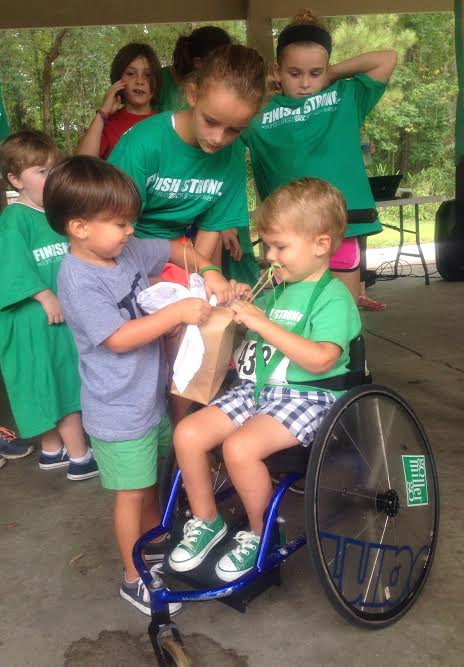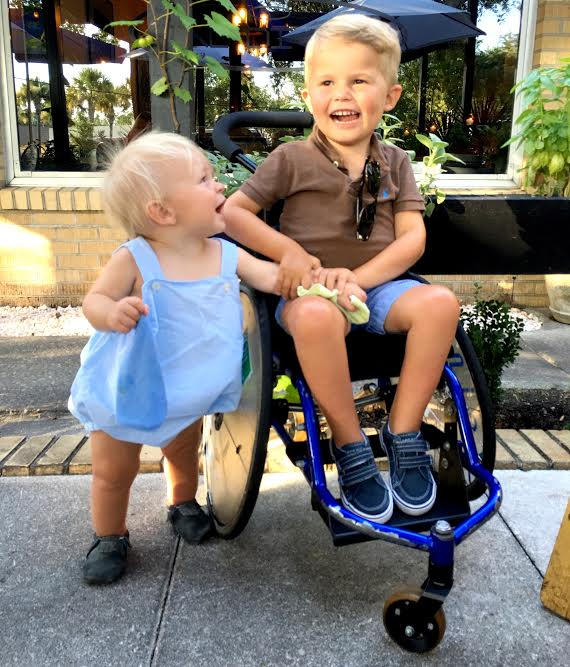Why can’t you walk?
Lindsay David use to toil over this question and fumble with words when responding to curious children and apprehensive adults, but her son Miller, who was diagnosed with Spinal Muscular Atrophy (SMA) when he was 15 months old, simply states: “My muscles don’t work sometimes, so instead of walking I use this chair. I also have big boots and a bike to help me stand.” With no prompting or educating, Miller came up with the response all on his own. “It’s so perfect,” says Lindsay, “He’s like ‘duh! I have a wheelchair to get me where I need to go’ and then off he rolls!” Miller has big brown eyes, blonde hair and a smile so infectious that the world can’t help but stop and notice him. His confidence and positive attitude inspire everyone he meets; even his parents feed of his upbeat and earnest energy. “After the diagnosis, Eason and I were incredibly angry and sad. We worried that he would have a miserable life and never find love, have a career, or a family of his own. In retrospect, our reaction was very telling of how people with disabilities are viewed by society: someone to be pitied. Now, through Miller’s innocent eyes, I realize people who are ‘differently-abled’ are not limited at all,” explains Lindsay. From runway models to attorneys, individuals with SMA continue to defy societal norms and contribute to the community in profound ways.
Atrophy (SMA) when he was 15 months old, simply states: “My muscles don’t work sometimes, so instead of walking I use this chair. I also have big boots and a bike to help me stand.” With no prompting or educating, Miller came up with the response all on his own. “It’s so perfect,” says Lindsay, “He’s like ‘duh! I have a wheelchair to get me where I need to go’ and then off he rolls!” Miller has big brown eyes, blonde hair and a smile so infectious that the world can’t help but stop and notice him. His confidence and positive attitude inspire everyone he meets; even his parents feed of his upbeat and earnest energy. “After the diagnosis, Eason and I were incredibly angry and sad. We worried that he would have a miserable life and never find love, have a career, or a family of his own. In retrospect, our reaction was very telling of how people with disabilities are viewed by society: someone to be pitied. Now, through Miller’s innocent eyes, I realize people who are ‘differently-abled’ are not limited at all,” explains Lindsay. From runway models to attorneys, individuals with SMA continue to defy societal norms and contribute to the community in profound ways.
No treatment. No cure. Terminal.
When the neurologist read the diagnosis out loud, Lindsay remembers feeling like there was no oxygen left to breathe in the room. Confused and scared, she questioned whether or not the results were accurate. “How could our son have a genetic, progressive, terminal illness that could take his life at any moment? Didn’t you just say he was on Miller Time?!” she recalls asking the doctor. SMA is a genetic disease that affects the motor nerve cells in the spinal cord. Similar to ALS, the terminal disease eventually takes away the ability to walk, talk, eat, swallow, and breathe independently, but it does not deteriorate cognitive ability. Apart from physical and occupational therapy to slow the process, no cure or treatment options are presently available. In the days and months following the diagnosis, Lindsay and Eason tried their best to put on a brave face for family and friends. “It was a difficult and dark period,” Lindsay recalls. “Then, about six months later, we began changing our outlook and, as result, we felt a peace about the situation. I know that Miller is going to thrive and shine and teach us all how to be more kind, accepting, truly happy, and how to live in the moment.” At the young age of four, Miller is already a remarkable example of goodness, perseverance, tenacity, and self-confidence.Hope for a cure.
August is SMA awareness month, and, according to the Cure SMA Foundation, major breakthroughs are just a few years away. In fact, the drug Biogen successfully completed its clinical trial and recently initiated its regulatory filings. This pharmaceutical drug improves motor mobility in infants diagnosed with Type 1 SMA. Additionally, gene therapy has shown significant advances in slowing the process of SMA and rehabilitating the spine. While therapies and products are in the pipeline, Miller continues to enjoy life to the fullest. A typical toddler, he enjoys playing on his I-pad, swimming, and cheering for his favorite football team -- Steve Gleason’s New Orleans Saints. He has physical and occupational therapy four times a week and attends preschool during the school year. Although he loves being a big brother, he has emphatically proclaimed that he does not want to play with his younger brother Simons until “he stops drooling!” Simons likes to roughhouse and since Miller’s bones are weak, Lindsay and Eason have to carefully monitor playtime together.Why won’t YOU walk?
The David family started Go Miller Go with the mission to give back to one of the first organizations that helps newly diagnosed families, educate the community at large about SMA, and raise funds to help further research for treatment. “Plus, I didn’t want to hide away. We want people to know about SMA and take away the stigma and “sadness” of a childhood disease by talking about it and having fun with it,” Lindsay adds. A supporter of Cure SMA and sponsor of the 2016 Go Miller Go 5K, NV Realty Group cordially invites you to walk with its team. The event takes place on September 10, 2016, at James Island County Park. Help find a cure for SMA so Miller can continue to teach those around him how to live boldly and happily, no matter the difficulty of life circumstances. To be a part of the NV Realty team, call 843-352-9088. For more information about SMA or the Go Miller Go 5K, visit www.curesma.org.
to help further research for treatment. “Plus, I didn’t want to hide away. We want people to know about SMA and take away the stigma and “sadness” of a childhood disease by talking about it and having fun with it,” Lindsay adds. A supporter of Cure SMA and sponsor of the 2016 Go Miller Go 5K, NV Realty Group cordially invites you to walk with its team. The event takes place on September 10, 2016, at James Island County Park. Help find a cure for SMA so Miller can continue to teach those around him how to live boldly and happily, no matter the difficulty of life circumstances. To be a part of the NV Realty team, call 843-352-9088. For more information about SMA or the Go Miller Go 5K, visit www.curesma.org.